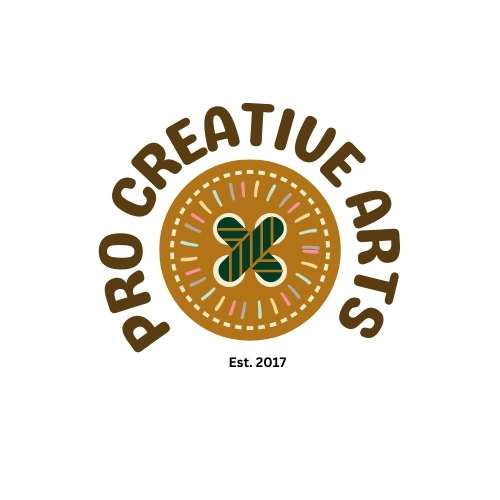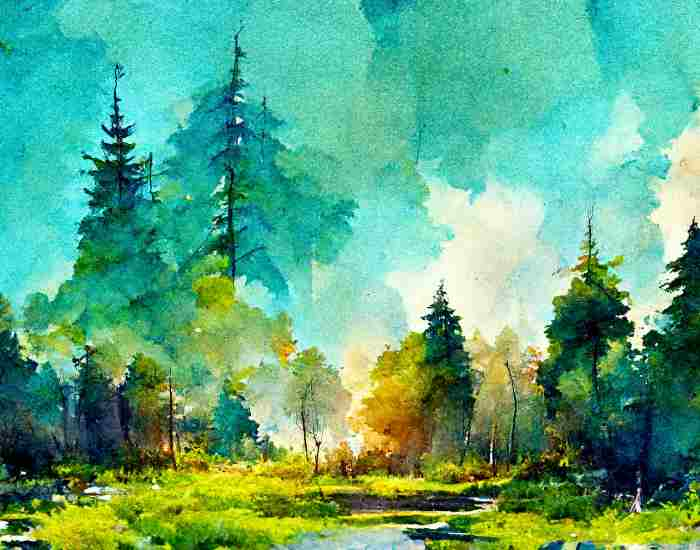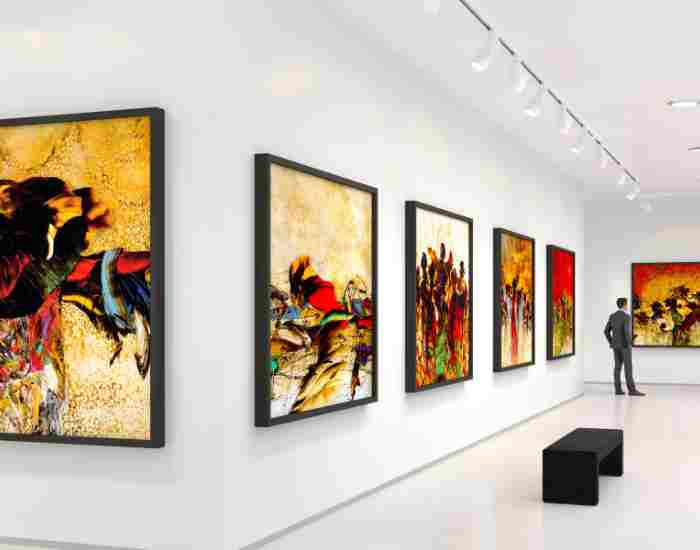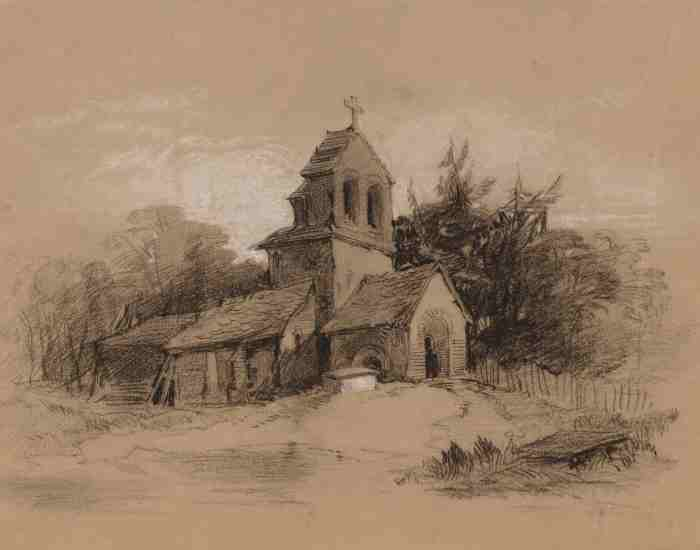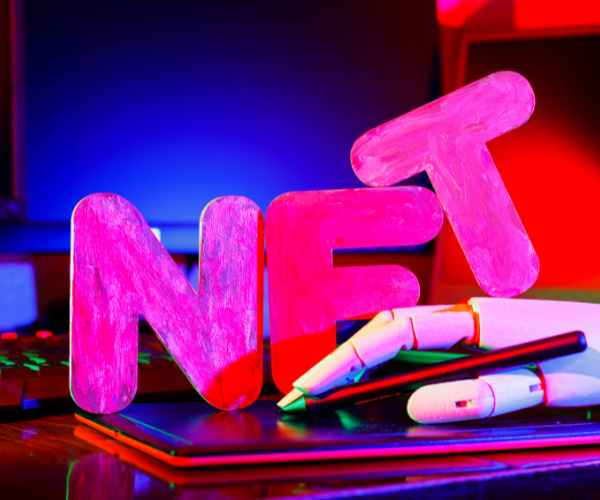Take today’s journey with us as we delve into the different forms of art and how it helps in the formation of our cultural or personal story. Be it a painting with its intricate brushwork, a sculpture crafted in striking shapes, a vividly captured photograph, or anything in mixed media; art of all kind has a unique story to tell. Over the course of our discussion, we will be incorporating both ancient and modern cases to question the concepts that surround the elaborative world of visual arts.
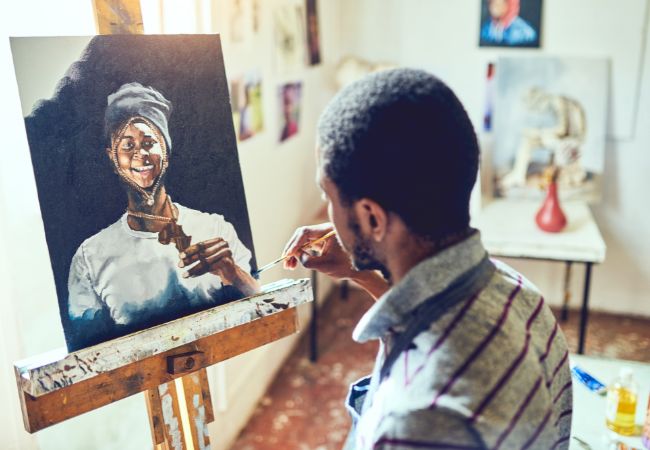
Painting: A Canvas of Colors and Styles
What are traditional and modern painting techniques?
The history of painting is the history of a skill that has been improved and transformed by artists throughout time. But even oil and watercolors are yielding to the advance of technology. Take oil as an example, it is a paint characterized by a shiny effect that has been in use since the 15 century, with masters like Vincent van Gogh and Rembrandt clearly showcasing its utility in their work.
Acrylic paint which dries quickly and is easy to use became used more frequently during the middle part of the 20th century with David Hockney taking a fancy to it. John Singer Sargent and modern artists such as Cathy Hillegas became popular for using watercolor. Due to its soft and transparent characteristics, it has gained popularity among Eastern and Western cultures.
In the modern world artists are developing new ways of sharpened visual creativity by incorporating traditional practices with modern ideas and digital techniques. For example political messages encompassed in spray paint are used by street artist Banksy, Takashi Murakami h useshints of digital graphics and traditional Japanese paintings to create beautiful eye-catching pieces.
In what ways did the 21st century boost the accessibility of Digital Art?
In today’s world, the technology that we have makes it incredibly easy for anyone to create and share art regardless of the skills they possess or their artistic knowledge. The 21st Century is undoubtedly the golden age of digital artists and art.
With the help of graphic tablets, applications, and a range of software, a multitude of tools are made available which allow artists to create their visions with unparalleled ease. And because of this art can now be displayed worldwide, especially on social media platforms. The advantage that digital art has over physical art is that it can be made cheaper or even free of cost while still looking professional and beautiful, making it accessible for the masses.
Now more than ever, we are seeing digital artists bloom into fully fledged business ventures as they sell their art on platforms like Etsy. But that’s not all. Social media has made a never before seen market potential for streamers and content creators through, in my opinion, digital art is a necessity. Companies are reaching out to digital artists with heartwarming offers to broaden their horizons for marketing and branding.
Sculpture: Making Art Become Tangible
How Did Sculpture Begin And Progress Over Time?
When looking at the vast timeline of human history, sculpture can be seen as one of the most ancient and crucial forms of expression. This type of art employs the use of materials such as wood, bronze, and marble to create figures in three dimensions.As for the Romans and the Greeks, they mastered the art of marble sculpture, creating masterpieces serving the ideals of human bean\’s beauty such as the Venus de Milo dated around 130-100 BC as well as Laocoön and His Sons, presumably sculpted in 323 BC.
But it was towards the medium of the Renaissance where marble sculpture found its true depth thanks to the works of Michelangelo and his deeply emotionally infused pieces such as the David created between 1501 and 1504 as well as the Pieta sculpted 1498-1499. If a piece was large and required intricate detail, then Bronze was the metal to employ since it was durable and slightly pliant when warmed, which Bernini utilized in constructing Apollo and Daphne between 1622 and 1625.
Today, bronze sculptors have expanded to different materials and technologies. This can be seen as an artistic and technological development. For instance, artists like Damien Hirst and Jeff Koons have employed contemporary materials such as stainless steel and aluminum while employing polished surfaces and mirror finishes in their consumer and self-identity sculptures.
How have sculptural techniques impacted the art?
Across the centuries, the techniques in sculpture have transformed drastically and this shift has affected the various sculptures movements especially in the range of concepts and ideas that artists carry out. The 20th century saw a form of art that can be referred to as abstract Approach; sculptors, like Pablo Picasso, and Henry Moore deviated from depicting things in a straightforward way and used sheet metals and simple retrieved objects embedded into sculptures as a more abstract approach. This form of abstraction was somewhat a response to various global changes which enhanced the spread of modernism and existentialism including technological progression and the two world wars.
In recent years, various sculptors like Anish Kapoor and Rachel Whiteread produced sculptures that distort concepts of space and form. This has fundamentally shifted the way sculpture artists create artwork. These artists utilize materials, like resin and powdered pigments, to help enhance their masterpieces. For example, Kapoor’s “Cloud Gate” (2004) is a perfect example of reflective steel sculpturing, while Whiteread’s “House”(1993) is a creative conceptualization of the interior of a Victorian house inside concrete.
Sculpture has also evolved mainstream mediums like painting, fashion, and photography in contemporary times. The incorporation of light materials into installation and performance art has created a fusion of physical and conceptual structures that go beyond traditional sculpture, installation and performance.
Photography: Framing the World
How has the art of photography progressed through the years since the nineteenth century?
The advent of photography as an art form, can be traced back to around 1839, in France, where Louis Daguerre honed this pioneer technique which was able to produce a permanent image with a camera. This previously elusive feat enabled photography to have an accurate semblance to real life, instantly marking it as an impressive breakthrough in the artistic domain. With this technique, traditional paintings were surpassed particularly when photography was modified for self-portraits. As cameras turned into political influences and events Realism came to fall.
With the advance of technology through the 20th century, there were significant advances in art, one of which being the 35mm film that advanced the Leica camera which dramatically changed the landscape of polaroid films and because of such fuels social and spontaneous movements. Photographic journalism began to flourish in this time continuously along with documentary photography. Signal moments in their time such as Lange and Cartier turned indelible quiet. Lange and Cartier were among the notable genographers who during the America the great depression played moments of real historical importance with indigent mothers in her famous picture ‘Migrant Mother’.
The late 20th and early 21st centuries heated up the digital revolution, significantly changing the ways in which photographs were captured, developed, and distributed. By the year 2001, the prevalence of digital cameras surpassed that of film cameras, and social media sites such as Instagram, which was launched in 2010, broadened and made photography easily accessible.
The work of photographers like Annie Leibovitz, who filmed while transitioning from the usage of a film camera to a digital camera helped shape art history the captured portrayal of prominent people and iconic events using a narrative-based approach that was wholly different from what was used this particular time period.
In What Ways Photography Is A Remarkable Genre Of Art?
Photography in comparison to other visual approaches is unique in that it documents specific events along with the subjects accurately and to the same extent as is not possible in other art forms. Other distinguishing features of the genre of photography include: its ability to encapsulate a still image of a moment, the interplay of the light and shadow in a single frame and the effects caused by the different components of the composition on viewers’ feelings.
By employing HDR, Time lapse, or long exposure photography, photographers have managed to create stunning images while subverting our understanding of movement and light. For instance, long exposure can make city landscapes look ghostly and empty, which enables us to focus on details that we would normally miss during the hustle and bustle of life.
In addition, photography has become intertwined with performing arts as well spurring some fusion styles. In theatre or cinematics, cameras and photographs have become an important addition for actors as they are used to capture images and videos of the scenes enabling better promotion of work done by Brigitte Lacombe. Contemporary art has also mixed the various use of performance art, video art, and photography to produce pieces like those of Bill Viola where still images and videos are used in combination, enhancing the experience for the viewer.
The Visual field of arts is broad and composed of multiple disciplines. Each discipline has its own role to play in driving culture. Video games, performance art and print making are a few of the disciplines which are demonstrative in how boundaries can be pushed into new territories which redefines what art is.
Since the 15th century, art such as wood carving, engraving, and lithography have been extremely important to artists, allowing them to produce that single image they have envisioned over and over again. It has played an important role in the reproduction and circulation of cultures and ideas, especially during the Renaissance period and later during social movements—works like those of Albrecht Dürer or even more current artists like Käthe Kollwitz. Most recently, Fairley’s “HOPE” poster is being donated to art museums by Obama and has risen as an emblem of the ‘Obamahood’ movement along with printmaking with artists such as Shepard having clouded the slope the end.
Artistic performance does not fit in responsibility with traditional art, on the grounds that it expands on a stage and includes an action which is presented by the author. It took on its character in the early 20th century as well as took shape because of artists such as Marina Abramović who specializes in long duration performances which essentially require both oral and physical energy. The socio-political issues of today are integrated into performance art within identity issues, gender issues and political issues which makes it an excellent societal critique.
Video games are now considered a new form of art that integrates storytelling, graphic design, and game play. And now, thanks to Lego and the Museum of Modern Art, titles such as “Journey” and “Shadow of the Colossus” are gaining recognition for their artistic and emotional creativity as well as for the technological advancements they have brought to the gaming industry. These games not only follow trends, but also create them while allowing people to consume art in new and exciting ways.
Andy Warhol, who went from painting to film to animation and now digital art, is a perfect example of an artist who masters all forms, which proves that the world of art is fluid and all definitions of different art – new and old – can be challenged. These demonstrate the vastness of human creativity and the unlimited potential for the art of expression.
How Do Crafts Such as Textiles, Pottery And Jewelery Influence An Individual’s Sense Of Authority And Community?
Crafts such as textiles, pottery, and jewelry do not only play art roles in society but also play a vital role in day to day living as means of expressing one cultural heritage and individual style. These simpler art forms are extensions of the craft and customs of the society.
Textiles have always been an essential form of art & craft for humans and that has been notable for the variation across cultures. For instance, certain Cowlitz tribes have created blankets with patterns that tell stories. Present day Faith Ringgold and other artists use textiles to communicate messages about culture and gender through their works.
One of the examples of Neolithic art would be pottery which includes items such as Terracotta warriors of china or greek pots. In today’s contexts, ceramics are no longer defined by the art but by the artist: modern potters like Grayson Perry challenge the boundaries of trendy design.
While still being a type of art that exists at the intersection between a practical function and an artistic vision, jewelry design in most cases conveys the specific style and background of the person who wears it. Early 20th century artisans like Suzanne Belperron and modern day designers such as Judy Geib are all trying to differentiate their craft by blending small art pieces and beautiful decorative pieces all made from unconventional materials.
Craft arts are not just meant to be ornamental. They are embedded with purpose and bound with precious stories.They are bridges linking past and present, and they ensure that traditional art forms do not perish through their good old amalgamation with modern culture and technology.
Sometimes Asked Questions
What is the concept of a visual art?
According to one defintion, visual art is any form of work that is created in a manner that can be enjoyed visually, and this includes painting, sculpturing, taking photos and using multimedia tools. It has features composed of form, color, line, texture and space and many times includes compositional aspects of design and even composition. As the National Endowment for the Arts indicates, the definition of visual arts comprises more than just drawings and paintings – artistic media such as installation and digital art are also encompassed.
How Have Different Cultures Left Their Mark on Various Art Forms?
Art is deeply rooted in culture, and it is evident in all forms of visual art. For example, African art is best known for its colorful masks and sculptures that have captivated modernists such as Picasso and Henri Matisse. Japan, on the other hand, is famed for its elegance and simplicity, which has influenced Western culture, especially in graphic art and even architecture. According to a study funded by the University of Tokyo in 2019, the influence of Japanese traditional art has also grown in the field of contemporary art, due to the “modernization” of the country and an “increased focus on nature” even in Western practices.
What Career Opportunities Exist Within the Visual Arts?
The category of visual arts covers a lot of professions, from the usual ones: a painter, a sculptor, and a photographer, to new ones: graphic designers, art directors, or digital artists. As of 2021, the U.S. Bureau of Labor Statistics notes that there are approximately 63% of artists that are self-employed and the rest are actively working in publishing, advertising and motion picture industries. Art therapy fields has also grown in importance, linking psychology and art for improvement of mental health.
How would you say technology has transformed the traditional forms of art?
Technology has enhanced, and completely altered the definition of visual art, this expansion has among other factors, been caused by the usage of digital tools and other software such as the development of pictures, art printing and virtual installation. Artists today have the means and resources to layer their artworks in ways that were impossible until recently. New technologies allow artists to work digitally in a sculpting game with incredible levels of realism and detail that clay modeling could only dream about. According to an Adobe 2020 research, digital arts are starting to integrate AI “to help break bounds of creativity,” and predicts that AI guided artwork will witness a 1000% increase in the next decade.
Conclusion
This clearly demonstrates the limiting nature of visual art and shows that creativity and the will to innovate are infinite, coming from and being applied by humans. Customary and current forms of visual art have transformed, mixed and evolved over time in order to fit in the diverse environments created by individuals in society. Visual art has today been employed to express both cultural and individual identity, as well as serve as technology.
In the future, the field of visual arts is bound to change, due to cultural exchanges and advancement in technology. The combination of new technological tools, reinterpretation of historical practices, and limitless conceptual approaches to creation are promising to keep the visual arts alive and relevant in society.
More Post
- What is crypto art, and how do you make it? Understanding What It Is and How to Create Your Own
- Commercial vs Print Modeling: The Ultimate Guide to Understanding the Differences
- Grids in Design: 9 Grid Design Layouts
- Graphic Design Composition: Mastering the 10 Crucial Graphic Design Elements
- Finding Inspiration Through the Vibrant World of Color Mixing
